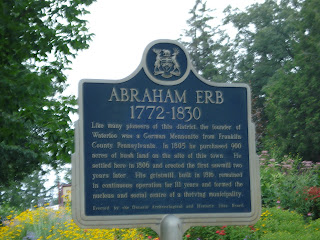So let us begin with a little historical context...Beginning in 1799 the first party came and scouted this area along the Grand River and its potential for farmland. The following year, in 1800, the first group of Pennsylvania German families (most of whom were Mennonite) began to arrive, clear the land and build homes for their growing families. They were a hardy lot and came well prepared but perhaps what set them apart from other settlers the most was their strong sense of duty to God, their families and their community as extended family—something that is called “Freundschaft”. It was the Freundschaft that erected barns, homes and even schools through what is known as construction or building bees. The community, collectively and individually, was as self-sufficient as possible. Some of the earliest services to the area included the erection of mills—such as saw mills and grist mills. Since the area was heavily wooded, saw mills proved to be invaluable in assisting the early farmer to clear lands for the planting of crops. This was quickly followed by the building of grist mills which were able to process the grain crops that were being grown. Having local mills meant that farmers could be more self-sufficient, locally processing their grain without having to travel great distances (for example, we know that in the early days, many had to travel to Dundas, Ontario to have their grains processed).
The
Early Years (new settlement, early education):
Along
with the establishment of their farms and community, then, education was very
important to the Pennsylvania German Mennonites who settled this area and was,
perhaps, second only to their faith in God. There were a few schools in the
area by the time the school was built in Waterloo--most notably, the first
school in Blair (near Cambridge) was built as early as 1802. None of these,
however, serviced Berlin (known today as Kitchener) or the community of Waterloo. It was
accepted then that children normally within 5 miles of an area walked to school—for
the children of today I say again—5 miles, through the woods, in the winter.
That’s right, school was normally convened only in winter months (and later was
expanded to include late fall) so as not to interfere with seasonal farming
duties such as planting, butchering, etc.
Prior to 1842 schools were voluntary but the
Pennsylvania German desire for their children to receive a good education was
strong.



No comments:
Post a Comment